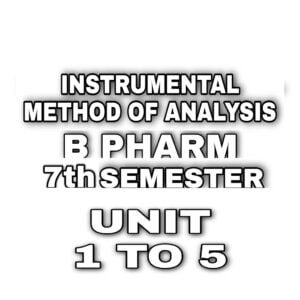Imperfect Pharmacy
B Pharmacy
Notes
7th Semester
INSTRUMENTAL METHOD OF ANALYSIS
Unit 1UV Visible spectroscopyElectronic transitions, chromophores, auxochromes, spectral shifts, solvent effect on absorption spectra, Beer and Lambert’s law, Derivation and deviations.
Instrumentation – Sources of radiation, wavelength selectors, sample cells, detectorsPhoto tube, Photomultiplier tube, Photo voltaic cell, Silicon Photodiode.
Applications – Spectrophotometric titrations, Single component and multi component analysis
Unit 2
IR Spectroscopy
Introduction, fundamental modes of vibrations in poly atomic molecules, sample handling, factors affecting vibrations
Instrumentation – Sources of radiation, wavelength selectors, detectors – Golay cell, Bolometer, Thermocouple, Thermister, Pyroelectric detector and applications
Flame Photometry
Principle, interferences, instrumentation and applications
Atomic absorption spectroscopy
Principle, interferences, instrumentation and applications
Nepheloturbidometry
Principle, instrumentation and applications
Unit 3
Introduction to chromatography
Adsorption and partition column chromatography
Methodology, advantages, disadvantages and applications.
Thin layer chromatography
Introduction, Principle, Methodology, Rf values, advantages, disadvantages and applications.
Paper chromatography
Introduction, methodology, development techniques, advantages, disadvantages and applications
Electrophoresis
Introduction, factors affecting electrophoretic mobility, Techniques of paper, gel, capillary electrophoresis, applications
Unit 4
Gas chromatography
Introduction, theory, instrumentation, derivatization, temperature programming, advantages, disadvantages and applications
High performance liquid chromatography (HPLC)
Introduction, theory, instrumentation, advantages and applications.
Unit 5
Ion exchange chromatography
Introduction, classification, ion exchange resins, properties, mechanism of ion exchange process, factors affecting ion exchange, methodology and applications
Gel chromatography
Introduction, theory, instrumentation and applications
Affinity chromatography
Introduction, theory, instrumentation and applications


